Aeonium Care: How to Grow These Rosette-Forming Beauties Indoors and Out
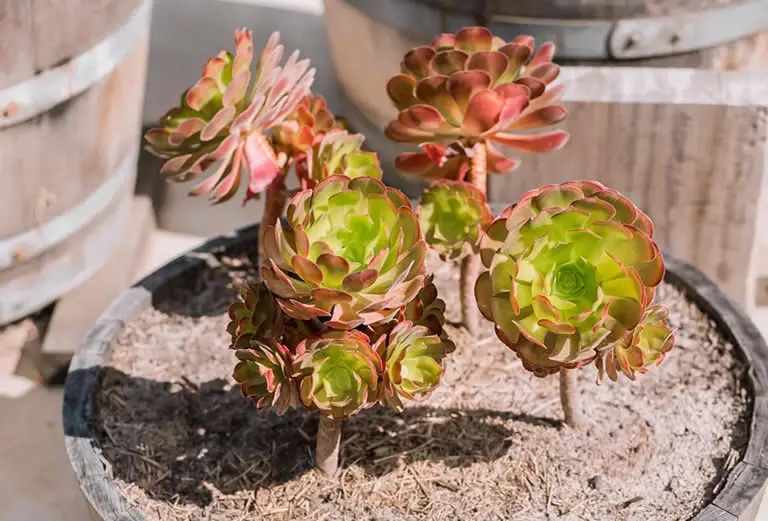
Aeoniums are standout succulents known for their striking rosette shapes, waxy leaves, and almost otherworldly color patterns. These slow-growing plants thrive in containers, rock gardens, or sunny windowsills and come in a range of forms—from petite groundcovers to bold branching shrubs.
Native to the Canary Islands, parts of North Africa, and Madeira, Aeoniums are unique among succulents for their preference for cool-season growth and their slightly higher tolerance for moisture than typical desert-dwellers.
Let’s explore how to care for these sculptural stunners and highlight some of the most sought-after varieties available today.
Table of Contents
- What Makes Aeoniums Unique
- Light Requirements: Bright, Indirect Light or Mild Direct Sun
- Watering: Moderate Moisture During Active Growth
- Soil and Potting: Fast-Draining with Good Structure
- Fertilizer: Feed During the Growing Season
- Pruning and Maintenance: Shaping and Propagation
- Best Spot in the Home
- Outdoor Aeonium Care
- Most Popular Aeonium Varieties
- Common Problems and Fixes
- Final Thoughts
What Makes Aeoniums Unique
Aeoniums belong to the Crassulaceae family and are best known for their fleshy, spoon-shaped leaves that form perfect geometric rosettes.
These succulents grow in cooler seasons (fall through spring) and often go dormant in hot summer months—especially when grown outdoors.
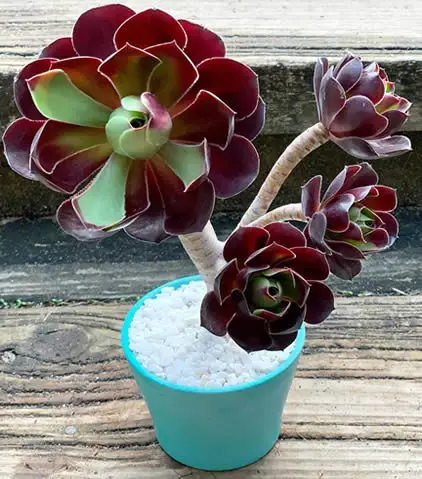
Unlike many other succulents, Aeoniums grow from a central stem that can branch over time, making some varieties resemble miniature trees.
Their range of colors—from neon green to deep burgundy—makes them eye-catching even in minimalist displays.
Most Aeonium species are monocarpic, meaning they flower once and then the rosette dies—but not before producing pups or branches that continue the plant’s life cycle.
Light Requirements: Bright, Indirect Light or Mild Direct Sun
Indoors, Aeoniums do best with bright, indirect light or a few hours of gentle direct sun daily. A south- or west-facing window is ideal.
Outdoors, they thrive in morning sun and afternoon shade or dappled light throughout the day.
Too much direct sun, especially in very hot climates, can scorch the leaves—while too little light can cause stretching and fading.
If your plant is leggy or its colors are dull, increase the light gradually and rotate it regularly to ensure even growth.
Watering: Moderate Moisture During Active Growth
Aeoniums like slightly more moisture than desert succulents but still require well-timed watering.
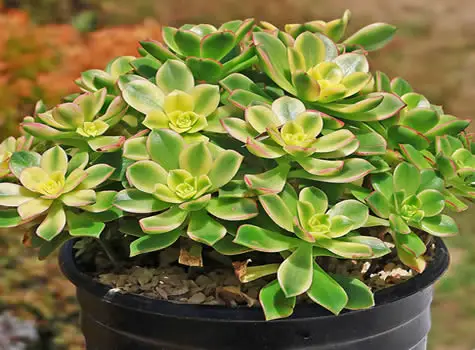
During their active season (fall through spring), water when the top 1–2 inches of soil is dry.
In summer, when many Aeoniums enter a rest phase, reduce watering significantly—just enough to prevent the leaves from completely shriveling.
Always use the soak and dry method: water thoroughly and let the soil dry completely before watering again.
Avoid getting water into the center of the rosette to prevent rot.
Soil and Potting: Fast-Draining with Good Structure
Use a light, airy cactus or succulent soil mix to prevent soggy roots.
You can improve a commercial mix or make your own using:
-
2 parts cactus mix or potting soil
-
1 part perlite or pumice
-
1 part coarse sand
Choose a pot with drainage holes, and avoid keeping the plant in decorative pots without proper airflow and drainage.
Repotting is rarely needed—every 2 to 3 years is enough, or when the plant becomes rootbound or the soil degrades.
Fertilizer: Feed During the Growing Season
Aeoniums benefit from light feeding during active growth in fall and spring.
Use a balanced, water-soluble fertilizer like 10-10-10, like this one, diluted to half strength, once every 4–6 weeks.
Avoid feeding during dormancy in summer.
Too much fertilizer can result in weak, overly lush growth.
If you prefer organic options, compost tea or diluted liquid kelp can also support gentle, healthy development.
Pruning and Maintenance: Shaping and Propagation
Remove dead or dried leaves from the base of the rosette to keep the plant looking tidy and reduce pest risks.
Prune leggy or overgrown stems by cutting just below a rosette and letting the wound callous.
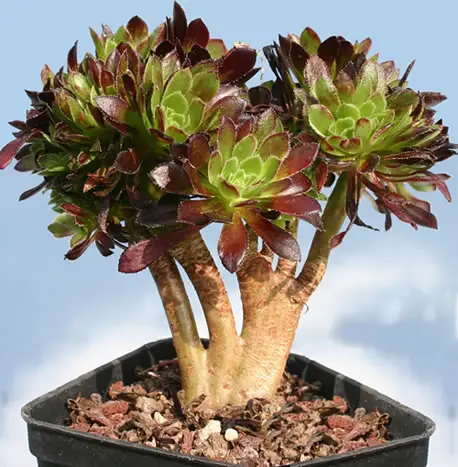
These cuttings can be propagated easily (we’ll cover that in the next article!).
Aeoniums don’t require much shaping, but pruning can encourage bushier, more compact plants over time.
Consider using healthy leaves or pruned stems to grow new plants as we outlined in the article Aeonium Propagation: 4 Easy Ways to Multiply These Striking Rosettes.
Best Spot in the Home
Aeoniums thrive in bright living rooms, sunny offices, and bright kitchens.
Smaller varieties can be kept in shallow dishes on windowsills, while larger branching types are great for sunny nooks or decorative pots.
They’re also beautiful on plant shelves mixed with trailing succulents or cacti.
Outdoor Aeonium Care
Aeoniums grow beautifully outdoors in USDA zones 9–11, where winters are mild and summers aren’t too dry or hot.
In these regions, they can be used in rock gardens, borders, and containers.
Plant in well-drained soil, and give them morning sun with light afternoon shade.
In very hot climates, they may go dormant in summer—leaves will close tightly, and growth may slow.
Reduce watering during this period and resume regular care in the fall.
Bring potted Aeoniums indoors if temperatures drop below 40°F (4°C), as most varieties are not frost-tolerant.
Most Popular Aeonium Varieties
Here are some of the most beloved Aeoniums grown as houseplants or outdoor specimens:
Aeonium ‘Mardi Gras’ – A stunning variety with bright green centers, deep purple edges, and red tones that intensify with sunlight.
Aeonium ‘Kiwi’ – A colorful tri-colored rosette with green, pink, and yellow hues. Compact, easy to grow, and ideal for windowsills.
Aeonium ‘Black Rose’ (Aeonium arboreum ‘Zwartkop’) – Known for its dramatic, deep burgundy to nearly black rosettes on tall stems. A favorite for bold containers and contrast.
Aeonium arboreum – The classic species with branching stems and bright green rosettes. Can reach 3–4 feet tall outdoors and works well as a focal plant.
Aeonium ‘Sunburst’ – A variegated variety with yellow and green rosettes that develop pink tips in full sun.
Aeonium tabuliforme (Flat Aeonium) – Grows as a large, nearly flat rosette with concentric leaf layers. Unique and low-growing.
Aeonium haworthii ‘Pinwheel’ – Small rosettes with pale green and pink tones. Grows well in both pots and garden beds.
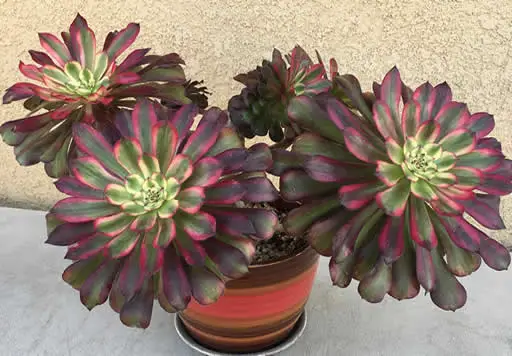
Aeonium ‘Velour’ – A cultivar similar to ‘Black Rose’ with velvety leaves that shift from green to burgundy depending on light.
These varieties are widely available online and through succulent growers, with ‘Kiwi’ and ‘Black Rose’ being especially beginner-friendly.
Common Problems and Fixes
Leggy growth
Caused by low light.
Move to a brighter location and consider pruning to reshape.
Shriveled or curled leaves
Usually a sign of underwatering, or normal dormancy in hot weather.
Water lightly and adjust care as needed.
Root rot
Due to overwatering or poorly draining soil.
Remove affected roots and replant in dry mix.
Leaf drop
Natural during dormancy or after environmental stress.
Give time and adjust care gradually.
Pests (aphids, mealybugs)
Remove manually with alcohol or spray with insecticidal soap.
Keep leaves clean and dry.
Final Thoughts
Aeoniums are sculptural, low-fuss plants that bring a pop of geometry and color to any collection.
Their seasonal growth pattern makes them unique among succulents, and their wide range of forms gives you plenty to play with.
Give them bright light, well-draining soil, and gentle watering—especially during their cool-season growth—and you’ll be rewarded with bold, beautiful rosettes that last for years.
Thanks for reading! I'm Michael — houseplant fanatic and your Pinterest plant guide.
Follow me on Pinterest for fresh updates 🌿



